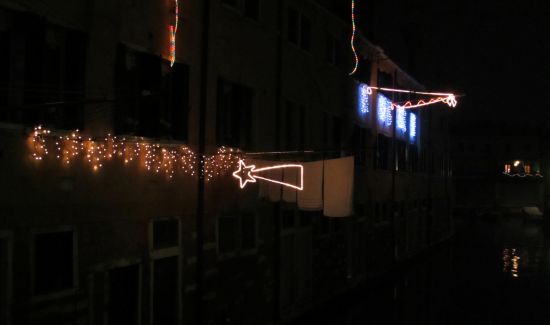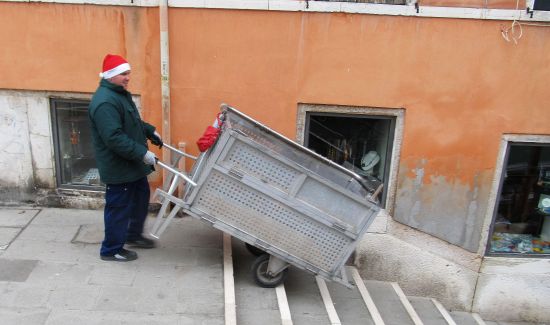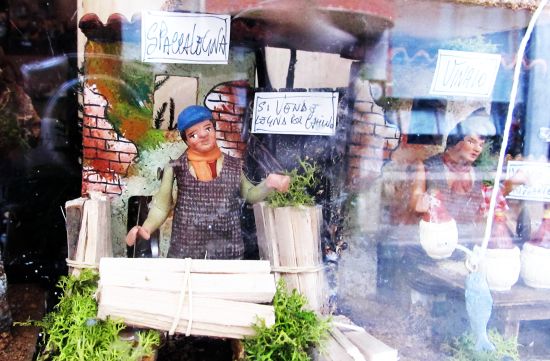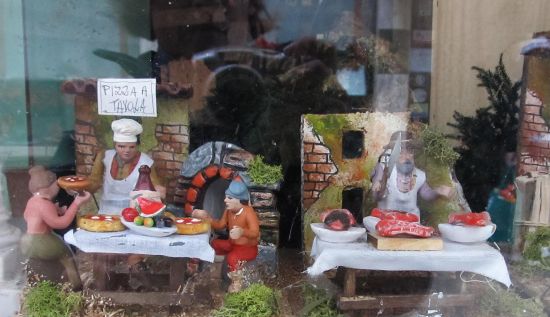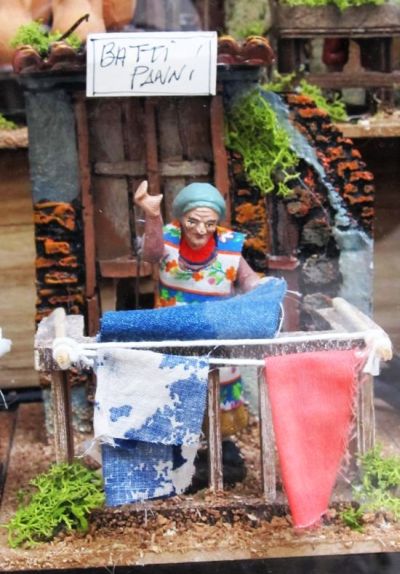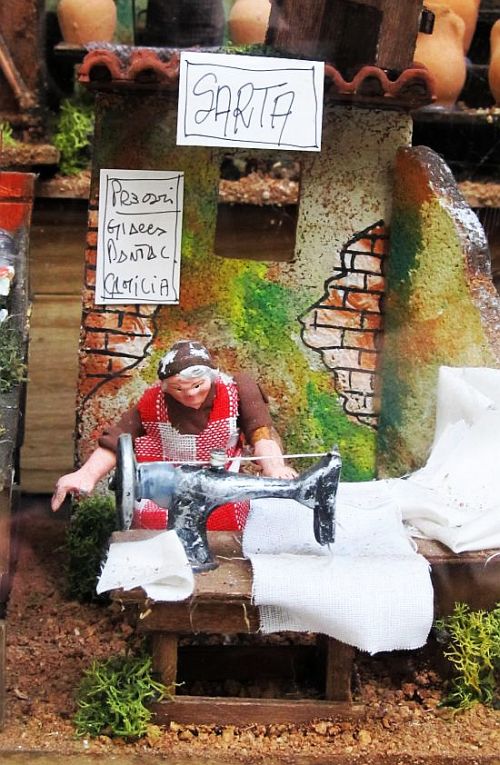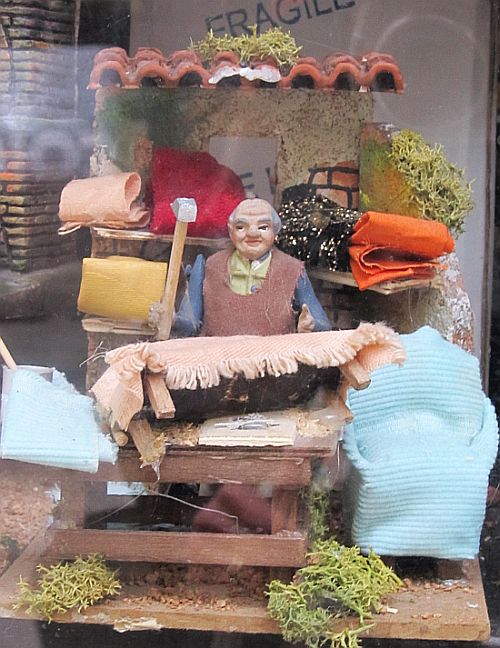Search results
9 results found.
9 results found.
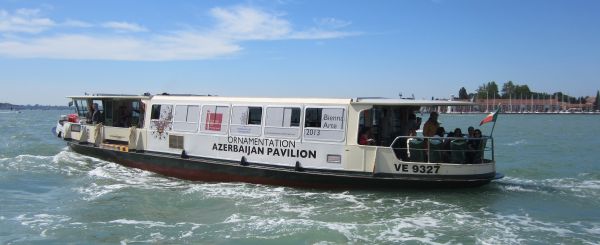
Despite the fact that “Biennale” literally means bi-annual (that is, every two years), this extravaganza of art has been broken up into so many different pieces — architecture, dance, music, etc. — that it has become, in some form or other, an annual event. Which means that at the beginning of June every year we live a week or so of intense spectatorhood at the swarming of the international art-scenesters.
For the brief period leading up to the inauguration (June 1 this year), we are entertained by an extraordinary spectacle of garb and behavior — I don’t mean this as a compliment — and the neighborhood businesses, especially bars and restaurants, get to earn some real money. If the visitors were the proverbial hay, the Biennale would be the proverbial sun, and the local merchants would be scything around the clock.
Short as this interlude may be, it causes all sorts of disorderly thoughts to rush into my brain — thoughts about art, thoughts about what it’s for and how it works, why or whether it matters, and thoughts about people (those are usually nasty, brutish and short — the thoughts, I mean, not the people).
I spent most of yesterday attempting to write them down and organize them so I could share their brilliance with you. But I gave up. Based on the art we see outside here, and the people who pursue it, art has become something so silly that to treat it as something serious has become an art form in itself.
The neighborhood is pulsating with journalists, art-watchers, art-commenters, and art-participaters. And I suppose also some lower-voltage art-perpetrators too, but I doubt that they are wandering around via Garibaldi, or blocking the streets drinking their spritzes where the space is narrowest (“You need to get through here? How quaint”), or leaning against things talking into their phones, drawing attention to themselves. My experience is that real artists rarely look all that important. Irving Penn looked like a vinyl-siding salesman.

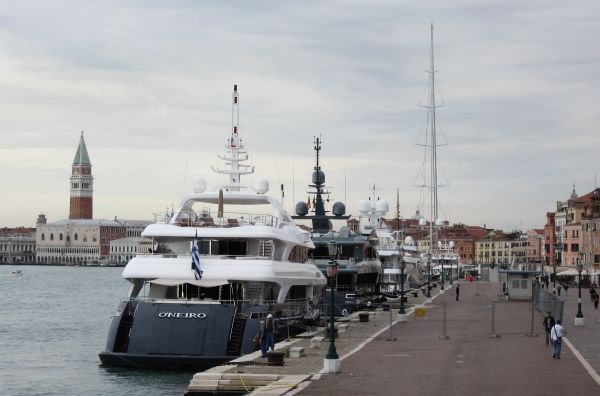
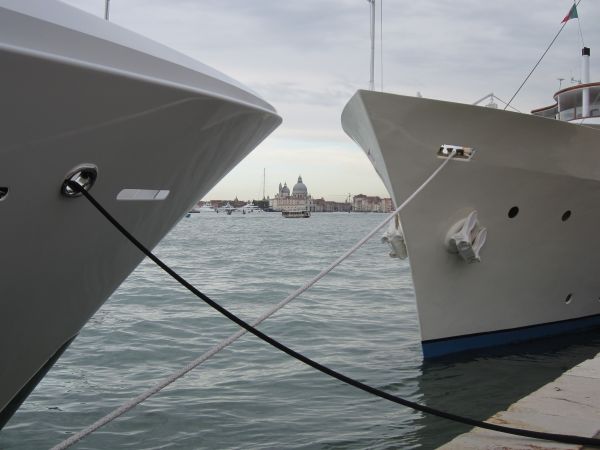
Every year there is one major work of art that takes center stage, or tries to. They are always put out along the fondamente, obviously, where they can’t not be seen.
The first year I was here, it was a monstrous concrete hand, half-emerging from the pavement, fingers reaching upward in what might have been a metaphoric expression of yearning — or pleading, or grasping — for freedom. Another year it was a five-story-high sort of stele, glowing night and day with a violently-blue neon sort of waterfall. That blighted the landscape for quite a while. Then there was the decrepit traditional wooden sailing boat from the Comoro Islands, encumbered with two ponderous dumpsters, that floated for months tied to some pilings as it slowly came apart. Oh — and there was the tree, planted on a specially-constructed platform, in front of the Giardini where there are masses of trees.
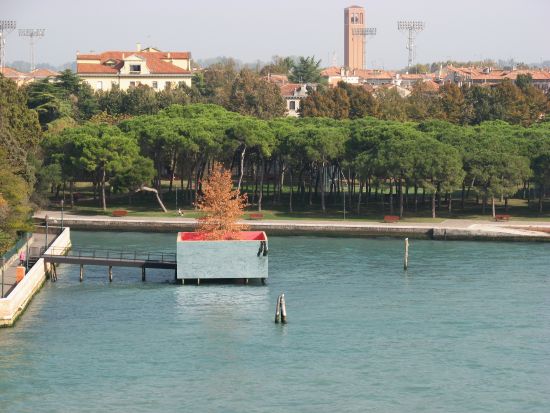
This year it is a gigantic figure on the island of San Giorgio sometimes known as “Alison Lapper Pregnant,” but at the moment called “Respiro” (“breath”). It is a portrait of English artist Alison Lapper, who was born as shown here (except obviously not 11 meters/33 feet high, purple, and inflatable). Don’t try to understand this by yourself; only Marc Quinn, the artist, and his assorted interpreters can tell you what it really means.
It’s actually very simple. I translate from a photo caption in Panorama.it: This handiwork “proposes a new model of feminine heroism in which love, maternity and vitality reach an unpredictable form and an unexpected peak.” It also is part of a “voyage from the origins of life” and “celebrates fear and wonder in the face of the world in which we live.” Other resonant phrases such as “the beauty and mystery of creation and life” defeat my capacity to link language to thought.
In case you might suppose that this artifact were some self-indulgent creation meant only to stupefy the Biennalists, or that the Palladian monument of the church of San Giorgio might be an inappropriate location for showing it (Peasant!), you should know that it has been exhibited at all sorts of places. It’s been in London since 2005 and was understandably given pride of place at the Special Olympics in London in 2012; other sites range from places associated with some sort of violence, such as a military training field in Tripoli, Libya; in Paris (protests against gay marriage); in Srinagar (protests in Kashmir); in Moore, Oklahoma (tornado tragedy), to more frivolous events which needed to draw more than usual attention to themselves, such as the competition in Berlin of “German models of the future,” to the beach at Long Branch, New Jersey, to Indianapolis, Indiana. She’s traveled more than I have.
With the deepest respect to the subject of this creation (I can’t call it a statue, but I can’t call it a balloon, either), the thoughts it inspires are not related to life, beauty, mystery, fear or wonder. Because I already know what it is. Like everything else on earth, it is a business. Or rather, part of a business. Mining mercury, molding ocarinas, feeding orphans, shoeing horses — all businesses.
Business is one of the fundamental building blocks of life, right in there with carbon, nitrogen, oxygen, hydrogen, phosphorus and sulfur. And here at the Biennale we see the business of art, which — say what you will — has very little to do with life, beauty, mystery, or wonder, though maybe fear could be seen as playing a part.
Back to Alison Lapper as depicted by her plastic portraitist. I’m all for symbolism, but I am repelled by fabricated symbolism that is tacked onto an invention which is essentially intended to promote the inventor. Artists promote themselves because they want to sell you their stuff. Although Ms. Lapper collaborated in this work for her own reasons, she is merely the vehicle by which Marc Quinn intends to make you notice him. If all he wanted to do was show the beauty and wonder of life, he wouldn’t have put his name on it.
I’m not going to say any more, because this is the point at which my thoughts diverge from my ability to express them.
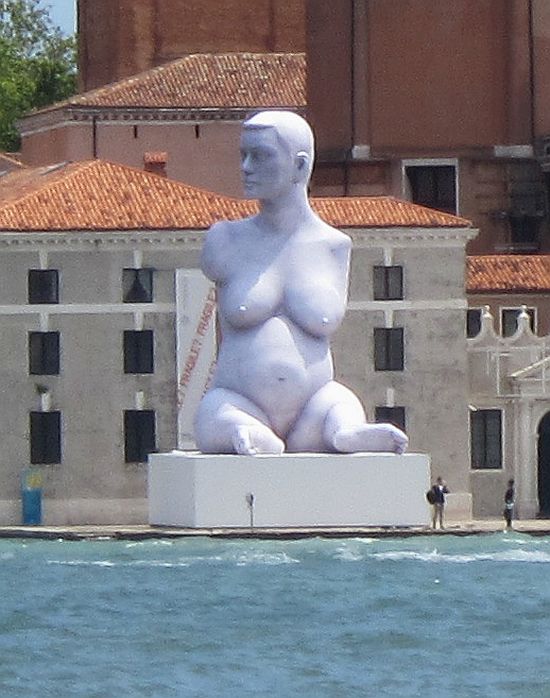
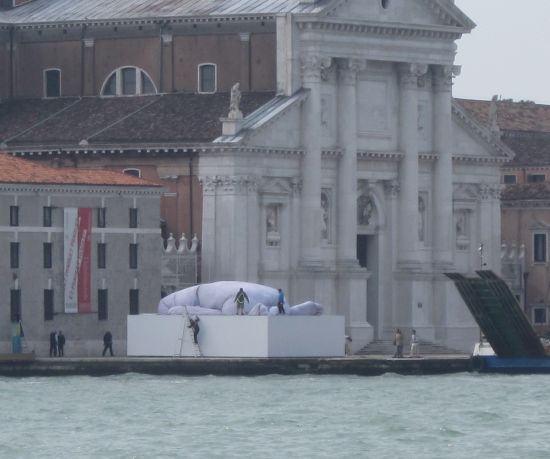
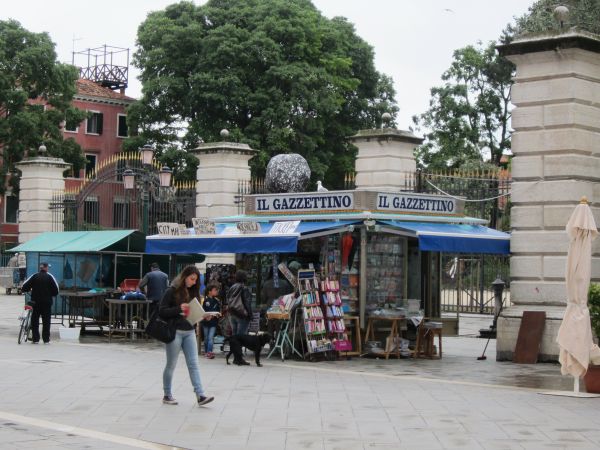

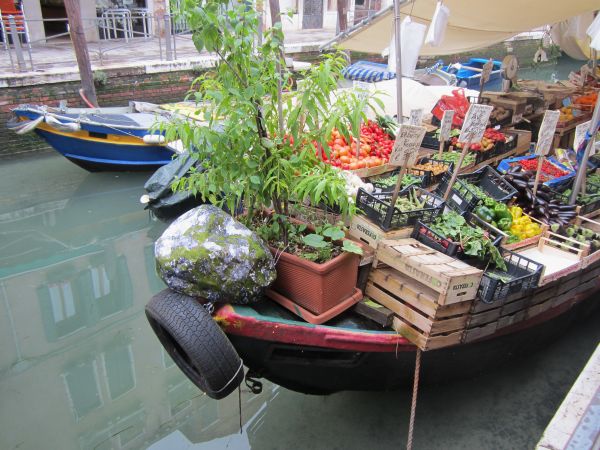
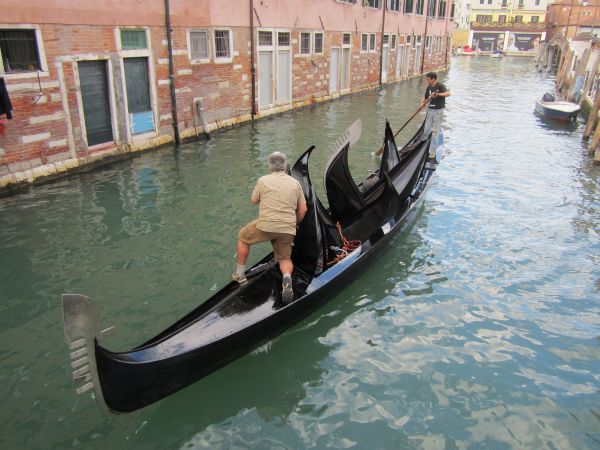
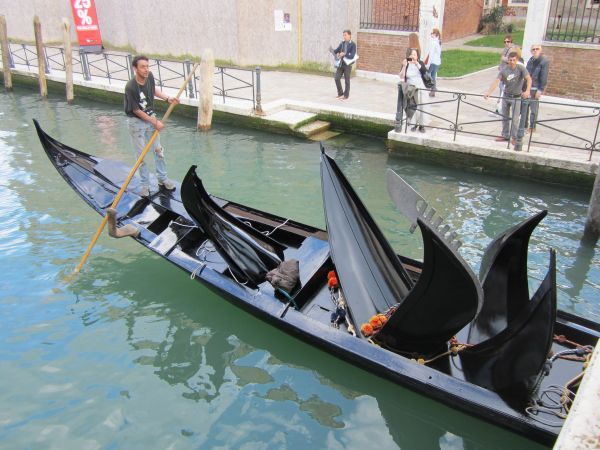
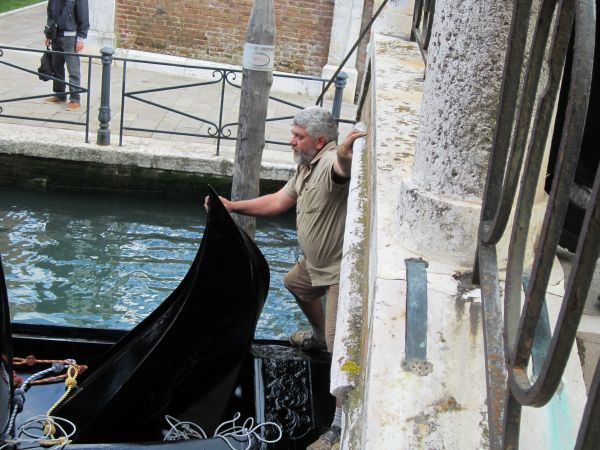
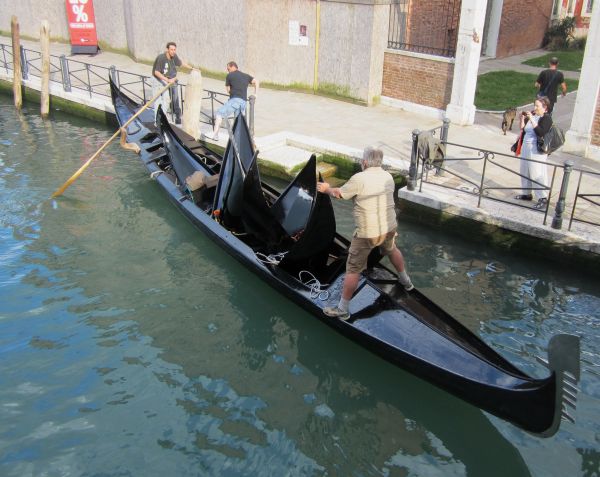
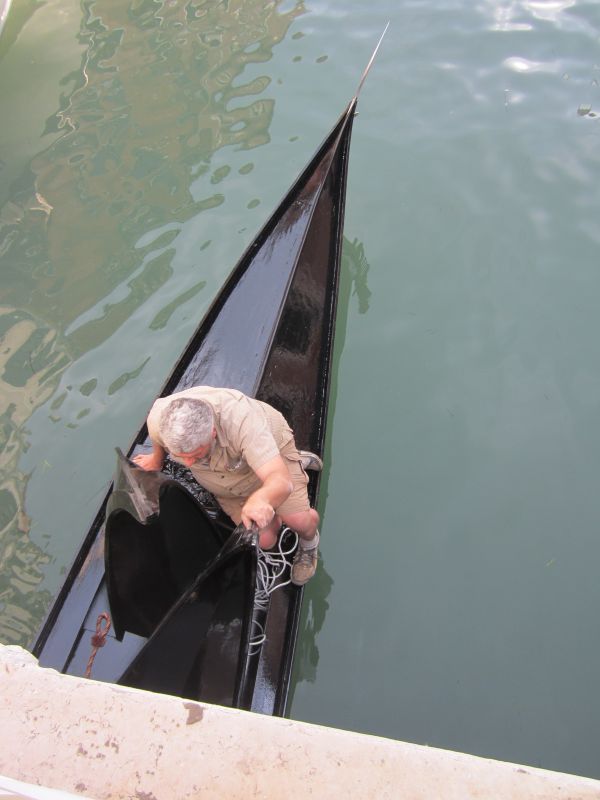
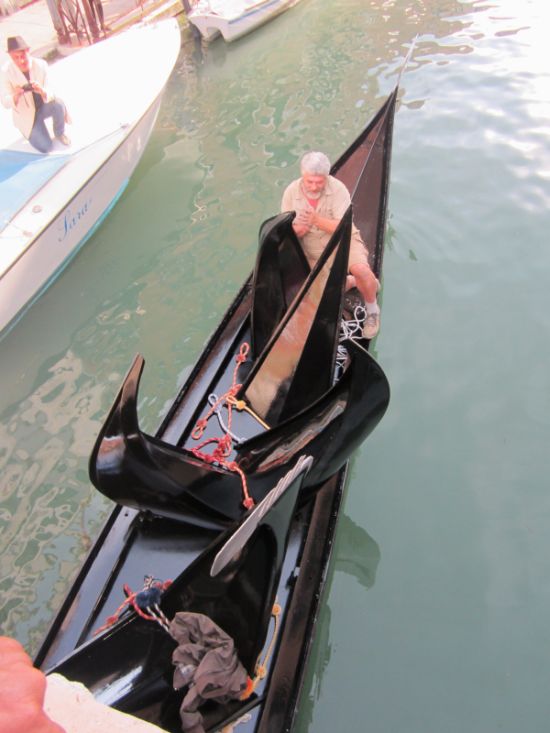
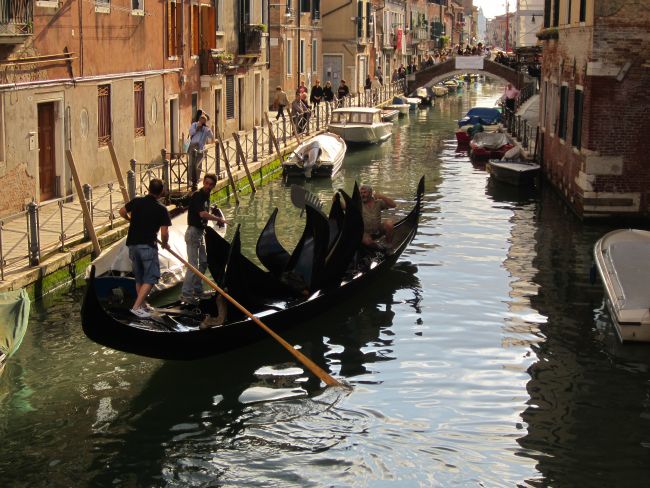
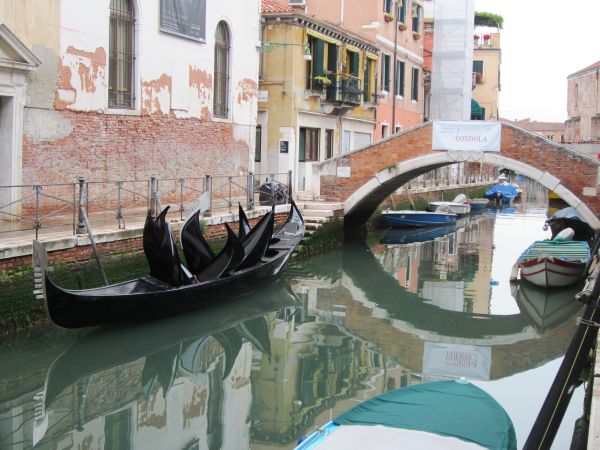
I will help you understand what this boat full of what looks like mussel-shells actually means: Study the explanation given here, take two aspirin, or a large grappa, or stick your finger in a live socket, and call me in the morning. It’s all art. All of it. Everything. Even your dirty-laundry basket and your old broken bike. You’re wasting your time doing whatever you do — you could be here in Venice, making people admire you.
Speaking of which, there is a wonderful scene in an extremely wonderful movie called “Le Vacanze Intelligenti” (The Intelligent Vacation) with Alberto Sordi. He and his wife are a late-middle-aged couple, fruit-and-vegetable sellers in Rome, whose highly educated children organize their summer holiday for them. No going to the beach this year — the parents are going to learn something! So the itinerary sends them to tour Etruscan tombs, and go to avant-garde concerts in Florence, and they finally end up in Venice, at the Biennale.
It’s summer, it’s sweltering, they’re exhausted, and while he goes off in search of a cold drink for her, she slumps, comatose, eyes shut, into the only available chair, under a tree. And people stop to admire her, and talk about what the artist had in mind, and how skillful he was, and how much she might cost if somebody wanted to buy her. The moment she comes to and realizes she’s been seriously mistaken for art is something sublime.

I am now re-establishing radio contact with the rest of the world. The recent crackling silence was completely predictable, at least to me. May is a great month if you’re a plant, but if you’re me, it’s an Olympic biathlon involving two of the city’s three biggest boating events: the corteo for the Festa de la Sensa, on Ascension Day (May 12 this year), and the Vogalonga (May 19).
Once again, I dedicated two weeks to working in the registration office for the Vogalonga. Sound simple? The first week, yes. The second week, right up to 6:00 PM the day before the event, was a crescendo of desperation — not on my part, but those who came, as one hollow-eyed supplicant put it, “A thousand kilometers over the Alps with our boats,” thinking they could sign up at the last minute and discovering that all the 1,700 bibs, one per boat, had already been booked.
I heard stories about people needing a number for their dying best friend. I didn’t hear any pleas based on expiring grandmothers or promises to small children, but the accumulated emotional tension began to take a toll on me. It wasn’t just the exclamations of doomed desire that were so tiring (“But why?” “But why?” “I have the money right here” “Can’t you find just one number for me?” “But I didn’t know” “I didn’t read the website” “I don’t have internet” “We’ve come all this way” “”Noooooooooooo, it can’t be truuuuuuuue”), it was my irritation at situations which could easily have been prevented if even one of their group had had a functioning medulla oblongata. Or whatever part of the brain governs logic and rationality. If there is such a part.
While everybody who already had their numbers were working themselves into a froth over the unpleasant weather forecast, I and my colleagues were struggling to resolve many silly and time-consuming and avoidable problems. Reservations made but not paid for; payments that didn’t correspond to the booking; adding people to boats; subtracting people from boats; doing long division of people from boats: the single reservation for 20 rowers who were assumed by us to all occupy the same boat, but which it turned out were each rowing by themselves, hence requiring 19 more numbers. That was fun. “You need 19 numbers? Sure, I’ll just make them right here for you, like Subway sandwiches. You want pickles?”
Compared to all that, rowing the event is almost always easier, and more enjoyable, and more, well, rational.
You might have heard that it rained; you might have heard that the rain was something epic! That some boats capsized! Frankly, it was all much better than I’d feared. The rain came down in hurled handfuls of big hard round drops, then shifted, like a shower-head, to fine, thin and steady, then heavy and steady, then lots of little drizzly drops, then another downpour, then a pause, then another downpour. After Mazzorbo, the sun came out and we all dried off. As for overturned boats, if you ride a horse, what can happen to you? You fall off. If you’re in a boat, what can happen? You fall in. Lino’s fallen in countless times. I’ve fallen in, in January, no less. Get a grip, people.
That said, however, falling in isn’t equal for everyone. We heard later from a friend who had been rowing in a big Venetian boat that at Mazzorbo a rower in a single kayak decided to cross their bow at the last moment, got dinged, and over he went. But he couldn’t manage to come up because he had lashed all sorts of accoutrements, luggage, supplies, and even himself, to his kayak, which meant he couldn’t manage to right it and he couldn’t get out of it either. Think about it. Think medulla oblongata. Happily, the Venetian rowers managed to haul him back over and up into the air, but it was a very close call.
They also saw another boat capsize (the reasons for this aren’t clear — we weren’t in a hurricane) — it was a kayak again, this time for two rowers which, as our friend explained, also contained two very small children, one of whom was about three months old. The only glimmer of intelligence in that scenario was that the presumed parents had fitted their kids with lifejackets. People like this shouldn’t be allowed out of the house, much less into a boat.
There was the by-now traditional logjam in the Canale di Cannaregio, caused by the by-now traditionally inept, vision-impaired, brain-dead coxswains on the long rowing shells who seem not to understand that their boat needs to keep going straight forward and that their job is to see that it gets done. Big long boats slewing around slaunchwise and getting stuck are like big expensive beaver dams forcing all the arriving boats to jam up. It’s not just that they create problems — they don’t know what to do to fix them. As we see in the video by a certain Bas Schols; here’s the link for those who don’t see the clip: http://www.youtube.com/watch?v=qRyEnCKno3o .
A close second for the prize for Best Way to Create Problems goes to the people who just stop rowing and sit there in their boat, usually in narrowish spaces or at blind corners. You can hardly ever discover a reason for this. Of course they’re tired; we’re all tired. But when they’re driving in the center lane of the highway back home, do they just stop when they feel like it and sit there? I feel doubtful.
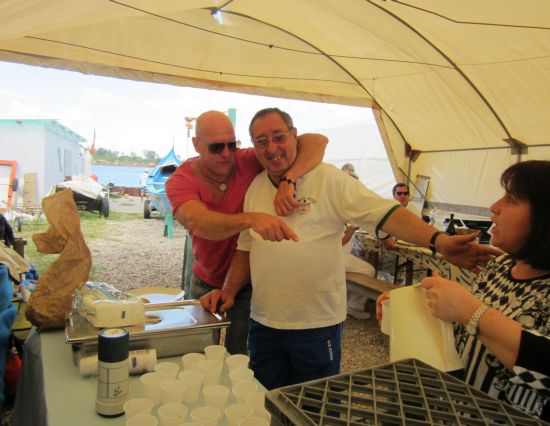
The Sunday before all this, May 12, was the Festa de la Sensa, and we participated in the commemoration of the “Wedding of the Sea.” We row out toward the Lido, following the big fancy ceremonial boat called the “Serenissima,” past the Morosini Naval School where the cadets are lined up along the embankment, as sharp as creases in starched organdy, shouting “Urrah!” when commanded to do so by the bosun’s whistle. That is absolutely the coolest thing about the entire event, though of course tossing the wreath into the water to commemorate the dead sailors is important too. And a ring-like object with ribbons tied onto it also gets blessed and tossed. Another chance to be crushed together in a boat-scrum, but at least here we all know each other and actually know how to move our boats around. That’s it for boats.
The rest of the month is a rapid unraveling of assorted appointments and events. For example, I sat most of the afternoon waiting for the long-expected boiler repairman to come replace the replacement washer from a few weeks ago. He was supposed to come in the morning, but only by calling up did we learn that he’d been moved to the afternoon. Dazzling efficiency! We could be in Sweden! Wait — it’s gets better. He phoned at 3:30 to say he couldn’t come because they hadn’t given him the part he needed to install. They thought they had, police said. (I am adhering to the practice recommended by the old city editor to the cub reporter, my former boss, who told him, “You can write anything you want to, as long as you add ‘comma police said.””)
At 6:00 it was off to the Generali Insurance Company’s boathouse for the presentation of the restored 8-oar gondolone. We needed to swell the ranks, it seemed, so we were there. We try to be good sports on land as well as sea. I was hoping they’d have cookies, but they got in a caterer and had hors d’oeuvres and asparagus risotto. I like being wrong like that.
Tomorrow afternoon Lino will be at Malamocco for hours, as one of the judges overseeing the eliminations for the next official rowing race (Sant’ Erasmo, June 2). That evening, dinner at the Non-Commissioned Naval Officers Club, a cholesterol-laden thank-you from a group of young French students because not only did we pick up the dropped/lost wallet of one of their members (containing 70 euros and also an address) but thanks to Skype and the fact that little Pauline’s father was home when I called, we managed to return it to her the next day. And a big shout-out to Mrs. Rideout and Mrs. Gordon, whose draconian French courses in high school are still paying off, if only in fractured form.
Friday evening, the annual corteo to transport the statue of Our Lady of Succor (“Maria Ausiliatrice”) from the church of San Pietro di Castello to the church of San Giuseppe. This year we’re going to be carrying as many people as we can, hoping to transfer into Venetian boats many of those who usually follow us on foot along the fondamente.
Saturday, a batch of us are off to Burano to collect four of our tornado-devastated boats from the boatyard where they have been repaired. We’re either towing or rowing them back; it doesn’t seem clear yet which one. I’m for rowing, myself, not that anyone consults me. The forecast isn’t too pretty.
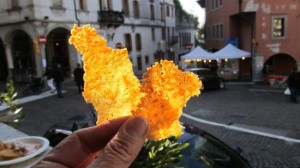
Sunday, we’re going with a big group in a bus to Trieste to the annual reunion of the veterans of the Automobile Corps. Lino did his compulsory 18-month military service in Rome with this arm of the armed forces, repairing and maintaining Jeeps, trucks, and assorted ministerial vehicles. He recently joined the nearest chapter of the motorized veterans, and the big outing sounds like it’s going to be fun, except for the promised thunderstorms and drenching rain.
We’ll get to march around the Piazza dell’Unita’ d’Italia for a while, then go off to some countryside establishment to gorge on Friulian specialties (think San Daniele prosciutto and frico, or fried cheese) — possibly the true purpose of the expedition. Then to visit some famous nearby monastery blanketed by rose gardens. We’ll have to get up before 5:00 to get the train to Treviso, the starting point, but I’d walk to Treviso for a shot at a plate of frico.
Next week’s calendar is ominously empty. I say “ominous,” because you know how Nature feels about a vacuum.
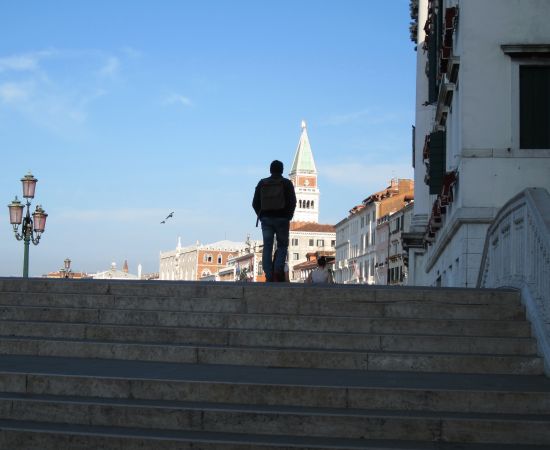
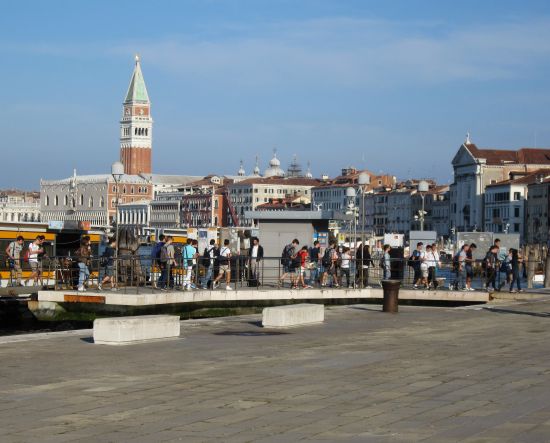

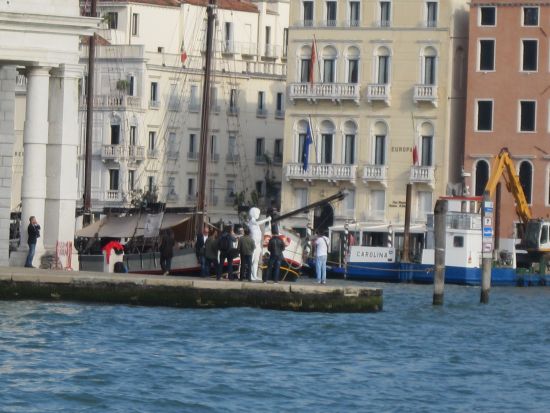

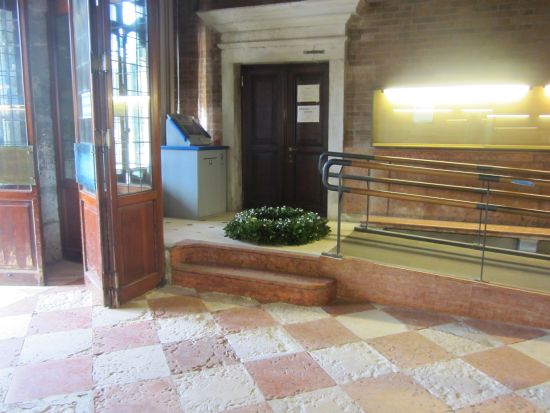
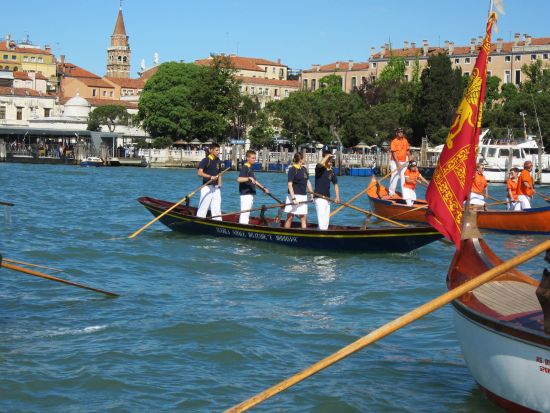

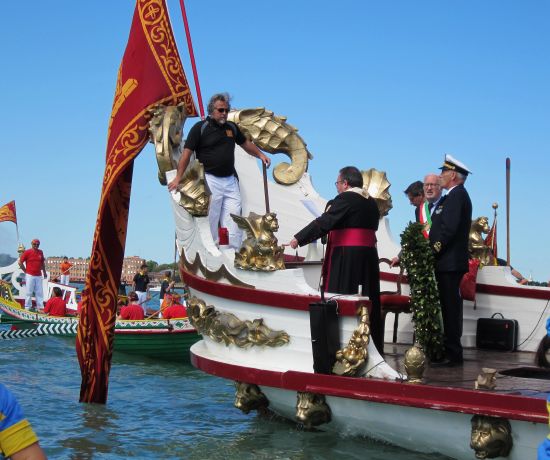
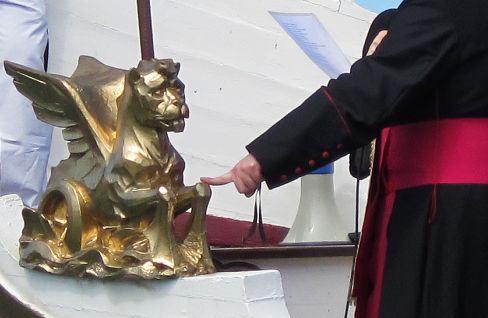
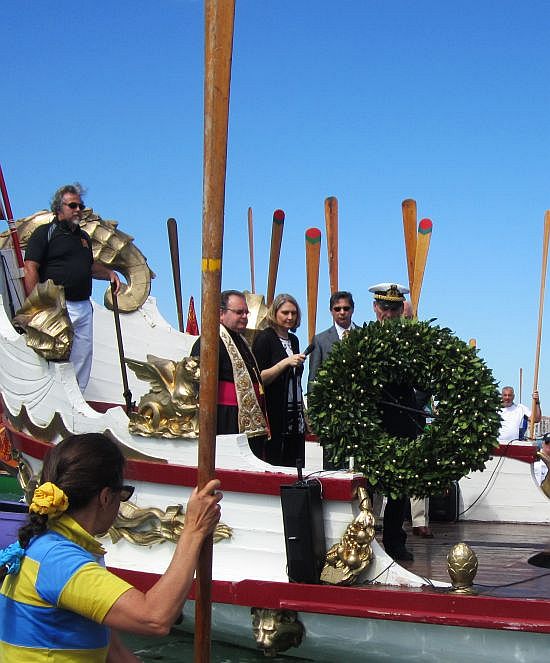

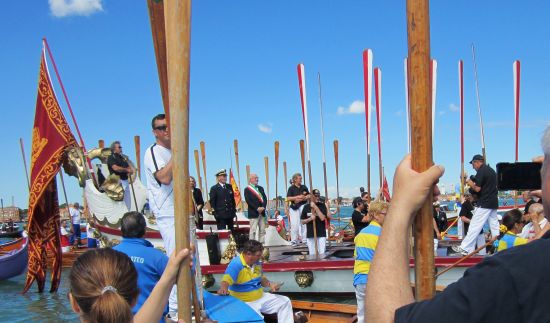

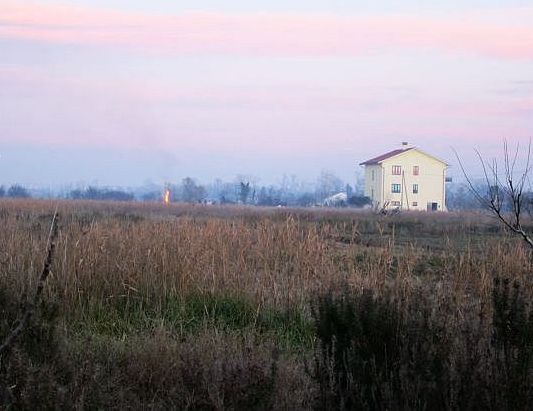
Last Saturday night, while you were doing whatever you do, we were on Sant’ Erasmo participating in a wild pagan ritual. It’s known as panevin (pahn-eh-VEEN)or, more simply, brusar la vecia (broo-zahr ya VEH-cha — burn the old woman).
I’ve experienced it many times from a downwind distance, inhaling the smoke of many faraway bonfires, but three days ago was the first time I ever participated. The Finotello family, whose market garden Sapori di Sant’ Erasmo has long since become our favorite produce store, told us they were going to be burning the old lady and sure, we could come too.
We always row over in a mascareta, partly because it’s a great motivation to go rowing, and also, not incidentally, the boat makes it easy to bring back our kilos of cauliflower or cabbage or tomatoes or eggplant or whatever’s good that day.
So around 4:00 we wandered across the span of lagoon between Castello and Sant’ Erasmo, threading our usual path along the flank of the Certosa and Vignole islands. The sun was going down, and it felt a little like we were sneaking out of the dorm after curfew, to be going out at the time we’re usually heading home.
I’ve written at other times about the history of this prehistoric practice, which is especially at home in the Northeast of Italy, so I’ll limit the scholarly details. It’s enough to remember that the effigy represents the old (year, primarily) and therefore must be extinguished as a propitious start to the new (year, of course); that it’s an excellent way to dispose of the year’s prunings, which would have to have been burned eventually anyway; and that it’s a great excuse to end the holiday season with a party that also can keep you warm.
Needless to say, people in Mestre complained about the smoke (I say “needless,” because nothing happens here without some wail of protest from somebody, including me). It wasn’t the fumes from Sant’ Erasmo that bothered them, but from various places close to the city. Unbreathable air! We had to stay shut in our houses with all the windows and doors sealed! Call the fire department, something’s burning!
I give a little slack to people with genuine pulmonary issues, or anyone who might have encountered smoke caused by burning rubber or plastic.
Otherwise, here’s my message to the good burghers of Mestre: Get over it.
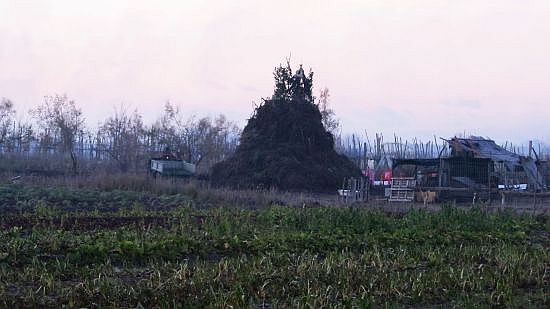
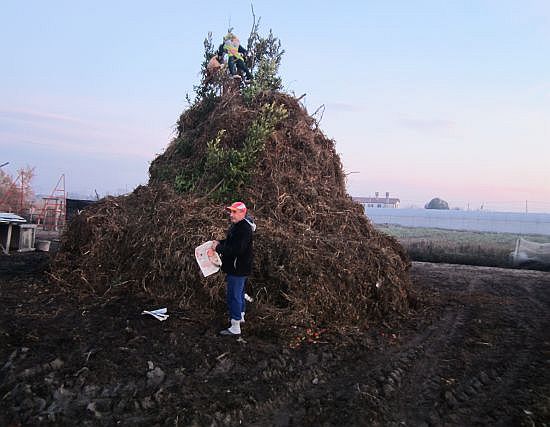
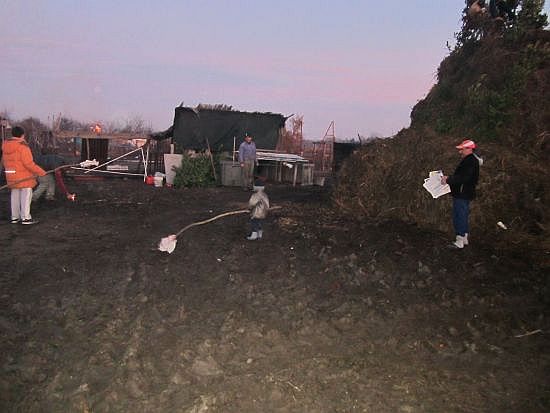
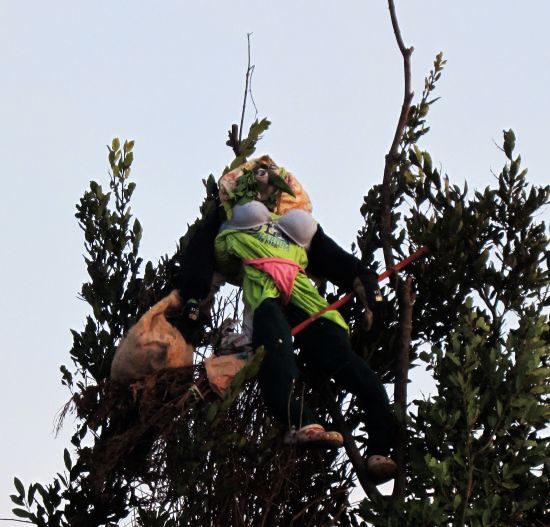

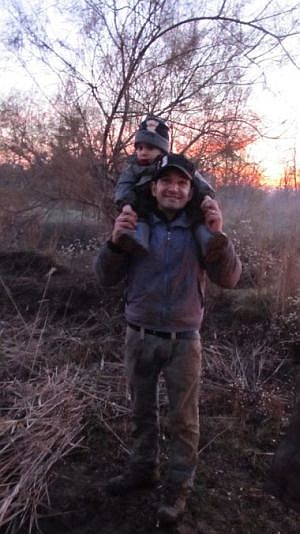
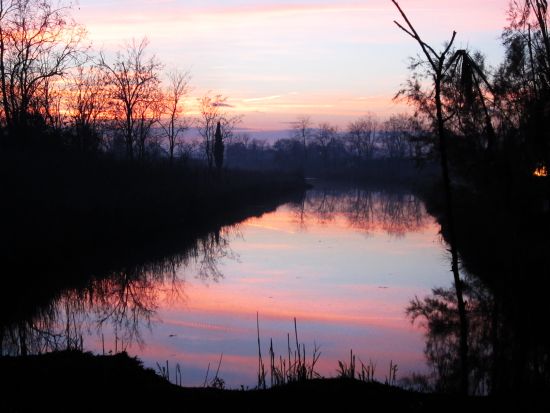
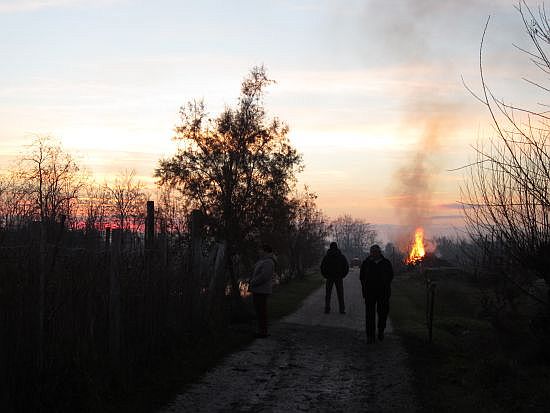
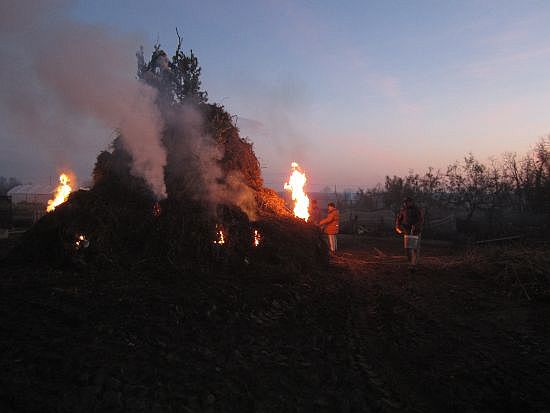
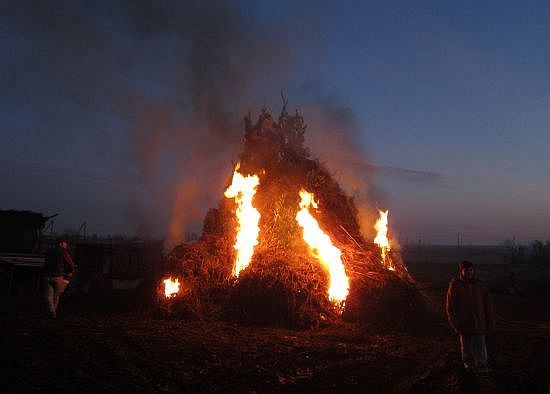


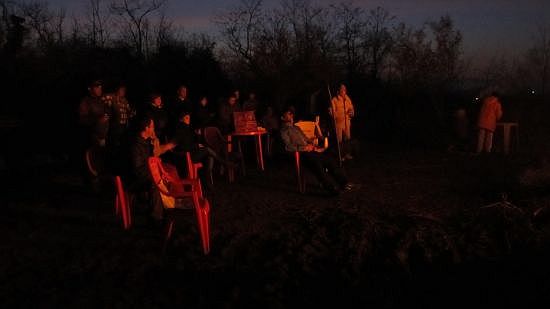
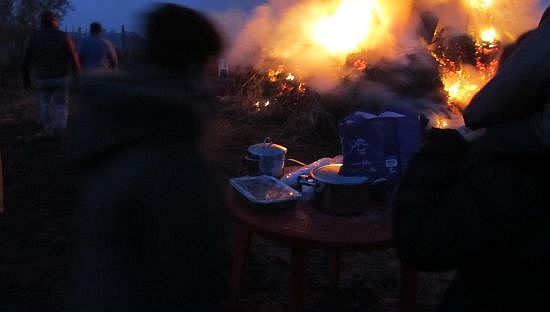
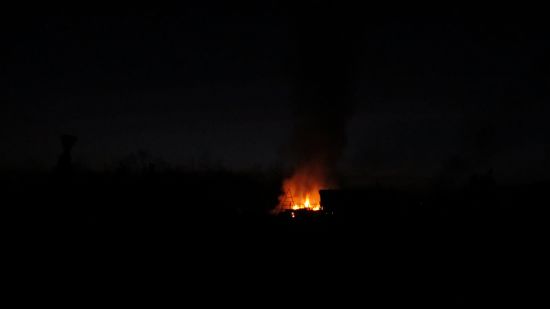
But the blaze wasn’t the only beautiful experience that evening. We got a massive bonus with the row home in the dark. I suspected we would, because we often used to row at night. But years have passed since our last “notturna.”
The lagoon isn’t ever ugly, but it’s like Gloria Swanson — at some moments it’s more beautiful than at others. At noon on a summer Sunday you will not see it at its best.
At night, though, and especially in the winter, it is a place of deep, luminous glamour. The silence, the stillness of the water, the sense of space, the stars, the cold — all the components join to make something much greater than the whole.
I didn’t even try to make any photographs because I knew they would never show what was really there. The barely perceptible movement of the water’s silky surface responding to the oars, which I could sense in my hands and then, from the bottom of the boat, through my feet; the small sound of the oars themselves, slipping through the water and occasionally squeaking against the humid wood of the forcola; the frigid damp of the oar chilling my bare fingers. The coldness of the air that I could breathe all the way down to the bottom of my lungs. The bright white dot of Venus reflected in the water, which floated next to us all the way home on our port side, bobbing back up after every stroke. The misty beam of the lighthouse on Murano shining straight out to sea through the inlet at San Nicolo (4 flashes, 2 seconds pause) and the unexpected way that it appeared closer to us at one point, then five minutes later seemed to be miles away, even though the physical distance had barely changed.
A mere two miles (3.6 km) from the bonfire to our house felt like some pilgrimage suspended in time. In the dark, the lagoon seemed untethered from everything that wasn’t it. No longer was it the plodding, workaday lagoon, the watery equivalent of an enormous Wal-Mart parking lot forced to marry an interstate interchange, but something whole, completely itself, majestic, complex, lacking nothing, needing nothing.
We crossed the Canale delle Navi by the Arsenal and rowed down the rio di San Pietro. Boats, walls, houses, windows, but no people. It was only 7:00 PM and there wasn’t even the sound of a person. We turned into the rio di Sant’ Ana — deserted. Nobody on the fondamenta. Nobody on the bridge. Silence. It was eerie. Beautiful, I guess, but it was as if the lagoon had just let itself go and obliterated everybody but us.
But of course, it hadn’t. At the end of the canal we could hear the Saturday-evening-going-home cacophony. Men shouting, dogs barking, kids wailing.
We now return you to your regular dimension.

Christmas this year (so far) has been the most subdued I’ve ever seen. It’s not the spirit that is lacking, but the fundage. I don’t need to remind you that yes, we have no money.
Christmas lights no longer festoon via Garibaldi, though a few indomitable individuals have put up some illumination. I salute them. They obviously have nothing to fear from the energy companies.
And speaking of indomitable, I wouldn’t have thought it possible, but the neighborhood pastry-wizard has outdone himself in widening the space between size and price in his festive offerings. An ingenious little creation (note the use of the word “little”) of chocolate shavings and lumps of torrone, representing an Alpine village — the sort of thing which usually adorns a liquor-and-mascarpone-sodden cake — is now being offered without the cake. For the same inflated price. If I were to want to spend 30 euros ($40) for a plate of chocolate fragments, I would…. No, I wouldn’t, actually. If I had 30 euros to spend on a present, I’d give somebody a batch of bees via the Heifer Project. At least that way the gift would propagate. No propagation powers yet discovered in the world of ostentatious confections. End of sermon.
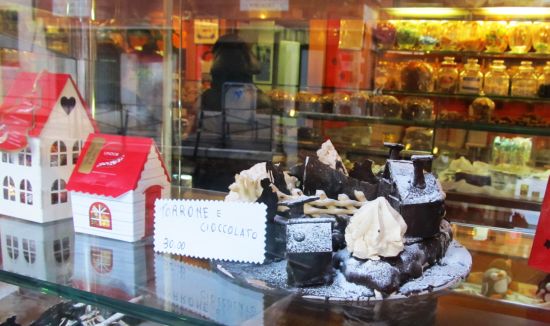
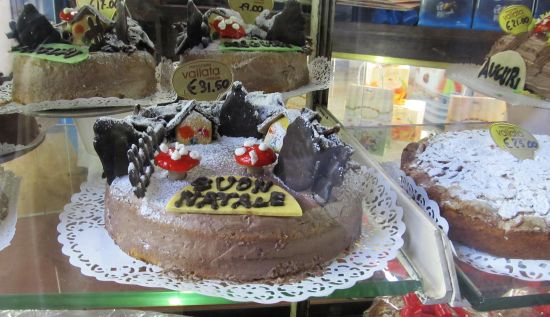
Day before yesterday, feeling the onset of the big day, we had a party at our rowing club. It was great. Because the tornado last June destroyed our clubhouse, we now cling to the edge of the lagoon with our boats parked under two big tents, with a container serving as locker room, kitchen, and bathroom. The kind of container they give to earthquake survivors. It works, but it’s not a long-term plan.
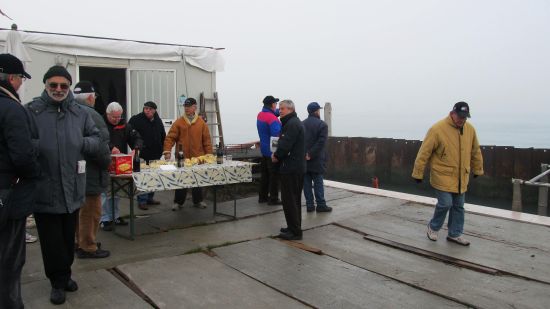
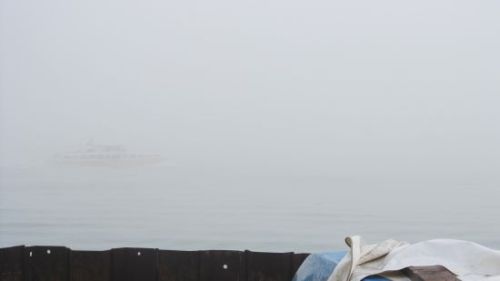
It was a modest, Bob-Cratchity sort of celebration but the most important elements were there: Fizzy wine (not the usual prosecco, but somebody’s home-bottled lambrusco), panettone and pandoro (my favorite, as is anything involving extra sugar), and smiling people. The frigid foggy wind was thrown in at no extra cost.
Another bonus was having time to hang around with some of the old guys and hear them geeze about the old days. I pick up unexpected bits of lore this way. This time I learned why gondoliers hate the nickname “pasta e oca” (pasta and goose).
Lino (whose grandfather was a gondolier, as is his son) says that they ate pasta and goose because they’ve always been “grandoni” — that is, tending toward the grandiose. Someone added, however, that in his opinion they hated being called this nickname because the dish (which I’ve never tried) is a sort of viscid, mucilaginous preparation which is so revolting it makes you want to barf. As it was told to me.
In any case, the preferred rejoinder to “Hey, pasta e oca!'” is “And yo’ mama gets the neck!”
Christmas spirit comes in all shapes and sizes, and I liked our standing-around-outside-in-the-freezing-soggy-air version. There weren’t very many of us, but it didn’t matter. This would be the only point on which I might agree with the pastry-shark. When it comes to a festa, it’s not about quantity.
So auguri (ow-GOOR-ee), as we say here. Technically, “good auguries.” We no longer practice divination by studying the liver of sacrificial animals, or the flight of birds, so I’ll translate this as “Good wishes!”
